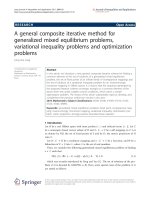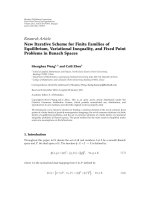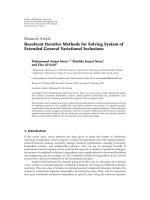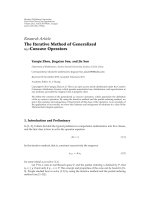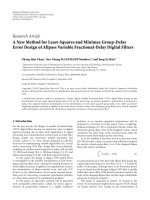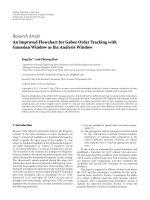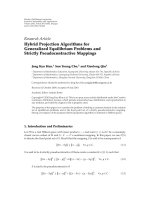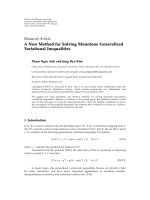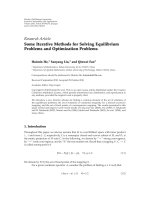Báo cáo hóa học: " Research Article An Iterative Method for Generalized Equilibrium Problems, Fixed Point Problems and Variational Inequality Problems" docx
Bạn đang xem bản rút gọn của tài liệu. Xem và tải ngay bản đầy đủ của tài liệu tại đây (551.39 KB, 20 trang )
Hindawi Publishing Corporation
Fixed Point Theory and Applications
Volume 2009, Article ID 531308, 20 pages
doi:10.1155/2009/531308
Research Article
An Iterative Method for Generalized
Equilibrium Problems, Fixed Point Problems
and Variational Inequality Problems
Qing-you Liu,
1
Wei-you Zeng,
2
and Nan-jing Huang
2
1
State Key Laboratory of Oil and Gas Reservoir Geology and Exploitation, Southwest Petroleum University,
Chengdu, Sichuan 610500, China
2
Department of Mathematics, Sichuan University, Chengdu, Sichuan 610064, China
Correspondence should be addressed to Nan-jing Huang,
Received 11 January 2009; Accepted 28 May 2009
Recommended by Fabio Zanolin
We introduce an iterative scheme by the viscosity approximation method for finding a common
element of the set of solutions of generalized equilibrium problems, the set of common fixed points
of infinitely many nonexpansive mappings, and the set of solutions of the variational inequality
for α-inverse-strongly monotone mappings in Hilbert spaces. We give some strong-convergence
theorems under mild assumptions on parameters. The results presented in this paper improve and
generalize the main result of Yao et al. 2007.
Copyright q 2009 Qing-you Liu et al. This is an open access article distributed under the Creative
Commons Attribution License, which permits unrestricted use, distribution, and reproduction in
any medium, provided the original work is properly cited.
1. Introduction
Let C be a nonempty closed convex subset of a real Hilbert space H and let Φ : C × C → R
be a bifunction, where R is the set of real numbers. Let Ψ : C → H be a nonlinear mapping.
The generalized equilibrium problem GEP for Φ : C × C → R and Ψ : C → H is to find
u ∈ C such that
Φ
u, v
Ψu, v − u≥0 ∀v ∈ C. 1.1
The set of solutions for the problem 1.1 is denoted by Ω,thatis,
Ω
{
u ∈ C : Φ
u, v
Ψu, v − u≥0, ∀v ∈ C
}
. 1.2
2 Fixed Point Theory and Applications
If Ψ0in1.1, then GEP1.1 reduces to the classical equilibrium problem EP and
Ω is denoted by EPΦ,thatis,
EP
Φ
{
u ∈ C : Φ
u, v
≥ 0, ∀v ∈ C
}
. 1.3
If Φ0in1.1, then GEP1.1 reduces to the classical variational inequality and Ω is
denoted by VIΨ,C,thatis,
VI
Ψ,C
{
u
∗
∈ C : Ψu
∗
,v− u
∗
≥0, ∀v ∈ C
}
. 1.4
It is well known that GEP1.1 contains as special cases, for instance, optimization
problems, Nash equilibrium problems, complementarity problems, fixed point problems, and
variational inequalities see, e.g., 1–6 and the reference therein.
A mapping A : C → H is called α-inverse-strongly monotone 7, if there exists a
positive real number α such that
Ax − Ay, x − y≥α
Ax − Ay
2
1.5
for all x, y ∈ C. It is obvious that any α-inverse-strongly monotone mapping A is monotone
and Lipschitz continuous. A mapping S : C → C is called nonexpansive if
Sx − Sy≤x − y 1.6
for all x,y ∈ C. We denote by FS the set of fixed points of S,thatis,FS{x ∈ C : x
Sx}.IfC ⊂ H is bounded, closed and convex and S is a nonexpansive mappings of C into
itself, then FS is nonempty see 8.
In 1997, Fl
˚
am and Antipin 9 introduced an iterative scheme of finding the best
approximation to initial data when EPΦ is nonempty and proved a strong convergence
theorem. In 2003, Iusem and Sosa 10 presented some iterative algorithms for solving equi-
librium problems in finite-dimensional spaces. They have also established the convergence
of the algorithms. Recently, Huang et al. 11 studied the approximate method for solving
the equilibrium problem and proved the strong convergence theorem for approximating the
solutions of the equilibrium problem.
On the other hand, for finding an element of FS ∩ VIA, C, Takahashi and Toyoda
12 introduced the following iterative scheme:
x
n1
α
n
x
n
1 − α
n
SP
C
x
n
− λ
n
Ax
n
,n 0, 1, 2, , 1.7
where x
0
∈ C, P
C
is metric projection of H onto C, {α
n
} is a sequence in 0, 1 and {λ
n
} is
a sequence in 0, 2α. Further, Iiduka and Takahashi 13 introduced the following iterative
scheme:
x
n1
α
n
u β
n
x
n
γ
n
SP
C
x
n
− λ
n
Ax
n
, 1.8
where u, x
0
∈ C, and proved the strong convergence theorems for iterative scheme 1.8 under
some conditions on parameters. In 2007, S. Takahashi and W. Takahashi 14 introduced an
Fixed Point Theory and Applications 3
iterative scheme by the viscosity approximation method for finding a common element of
the set of an equilibrium problem and the set of fixed points of a nonexpansive mapping
in Hilbert spaces. They also proved a strong convergence theorem which is connected with
Combettes and Hirstoaga’s result 3 and Wittmann’s result 15. Tada and W. Takahashi
16 introduced the Mann type iterative algorithm for finding a common element of the set
of solutions of the EP Φ and the set of common fixed points of nonexpansive mapping
and obtained the weak convergence of the Mann type iterative algorithm. Yao et al. 17
introduced an iteration process for finding a common element of the set of solutions of
the EPΦ and the set of common fixed points of infinitely many nonexpansive mappings
in Hilbert spaces. They proved a strong-convergence theorem under mild assumptions
on parameters. Very recently, Moudafi 18 proposed an iterative algorithm for finding a
common element of Ω∩FS, where Ψ : C → H is an α-inverse-strongly monotone mapping,
and obtained a weak convergence theorem. There are some related works, we refer to 19–22
and the references therein.
Inspired and motivated by the works mentioned above, in this paper, we introduce an
iterative process for finding a common element of the set of common fixed points of infinitely
many nonexpansive mappings, the set of solutions of GEP1.1, and the solution set of the
variational inequality problem for an α-inverse-strongly monotone mapping in real Hilbert
spaces. We give some strong-convergence theorems under mild assumptions on parameters.
The results presented in this paper improve and generalize the main result of Yao et al. 17.
2. Preliminaries
Let H be a real Hilbert space with inner product ·, · and norm ·,andletC be a closed
convex subset of H. Then, for any x ∈ H, there exists a unique nearest point in C, denoted by
P
C
x, such that
x − P
C
x
≤x − y∀y ∈ C. 2.1
P
C
is called the metric projection of H onto C. It is well known that P
C
is a nonexpansive
mapping and satisfies
P
C
x − P
C
y, x − y≥
P
C
x − P
C
y
2
2.2
for all x, y ∈ H. Furthermore, P
C
x ∈ C is characterized by the following properties:
x − P
C
x, y − P
C
x≤0,
x − P
C
x
2
y − P
C
x
2
≤
x − y
2
2.3
for all x ∈ H and y ∈ C.Itiseasytoseethat
u ∈ VI
A, C
⇐⇒ u P
C
u − λAu
, 2.4
where λ>0 is a parameter in R.
4 Fixed Point Theory and Applications
A set-valued mapping T : H → 2
H
is called monotone if for all x,y ∈ H, p ∈ Tx and
q ∈ Ty imply x − y, p − q≥0. A monotone mapping T : H → 2
H
is maximal if the graph
GT of T is not properly contained in the graph of any other monotone mappings. It is known
that a monotone mapping T is maximal if and only if for x, p ∈ H × H, x − y,p − q≥0
for all y,q ∈ GT implies p ∈ Tx.LetA : C → H be a monotone, L-Lipschitz continuous
mappings and let N
C
u be the normal cone to C at u ∈ C,thatis,N
C
u {w ∈ H : u − v, w≥
0, ∀v ∈ C}. Define
Tu
⎧
⎨
⎩
Au N
C
u, u ∈ C,
∅,u
/
∈ C.
2.5
Then T is the maximal monotone and 0 ∈ Tu if and only if u ∈ VIA, C;see23.
Let {T
n
}
∞
n1
be a sequence of nonexpansive mappings of C into itself and let {π
n
}
∞
n1
be
a sequence of nonnegative numbers in 0, 1. For any n ≥ 1, define a mapping S
n
of C into
itself as follows:
U
n,n1
I,
U
n,n
π
n
T
n
U
n,n1
1 − π
n
I,
U
n,n−1
π
n−1
T
n−1
U
n,n
1 − π
n−1
I,
.
.
.
U
n,k
π
k
T
k
U
n,k1
1 − π
k
I,
U
n,k−1
π
k−1
T
k−1
U
n,k
1 − π
k−1
I,
.
.
.
U
n,2
π
2
T
2
U
n,3
1 − π
2
I,
S
n
U
n,1
π
1
T
1
U
n,2
1 − π
1
I.
2.6
Such a mapping S
n
is called the S-mapping generated by T
n
,T
n−1
, ,T
1
and π
n
,π
n−1
, ,π
1
see 24. It is obvious that S
n
is nonexpansive and if x T
n
x then x U
n,k
S
n
x.
Lemma 2.1 see 24. Let C be a nonempty closed convex subset of a real Hilbert space H.Let
{T
n
}
∞
n1
be a sequence of nonexpansive mappings of C into itself such that
∞
n1
FT
n
/
∅ and let
{π
n
}
∞
n1
be a sequence in 0,σ for some σ ∈ 0, 1. Then, for every x ∈ C and k ∈ N {1, 2, },the
limit lim
n →∞
U
n,k
x exists.
Remark 2.2 see 17. It can be known from Lemma 2.1 that if D is a nonempty bounded
subset of C, then for >0, there exists n
0
≥ 1 such that for all n>n
0
sup
x∈D
U
n,k
x − U
k
x≤. 2.7
Fixed Point Theory and Applications 5
Using Lemma 2.1, one can define a mapping S of C into itself as follows:
Sx lim
n →∞
S
n
x lim
n →∞
U
n,1
x 2.8
for every x ∈ C. Such a mapping S is called the S-mapping generated by T
1
,T
2
, and
π
1
,π
2
, Since S
n
is nonexpansive, S : C → C is also nonexpansive. If {x
n
} is a bounded
sequence in C, then we put D {x
n
: n ≥ 0}. Hence, it is clear from Remark 2.2 that for an
arbitrary >0 there exists N
0
∈ N such that for all n>N
0
S
n
x
n
− Sx
n
U
n,1
x
n
− U
1
x
n
≤sup
x∈D
U
n,1
x − U
1
x≤. 2.9
This implies that
lim
n →∞
S
n
x
n
− Sx
n
0. 2.10
Since T
i
and U
n,i
are nonexpansive, we deduce that, for each n ≥ 1,
S
n1
x
n
− S
n
x
n
π
1
T
1
U
n1,2
x
n
− π
1
T
1
U
n,2
x
n
≤ π
1
U
n1,2
x
n
− U
n,2
x
n
π
1
π
2
T
2
U
n1,3
x
n
− π
2
T
2
U
n,3
x
n
≤ π
1
π
2
U
n1,3
x
n
− U
n,3
x
n
.
.
.
≤
n
i1
π
i
U
n1,n1
x
n
− U
n,n1
x
n
≤ M
n
i1
π
i
2.11
for some constant M ≥ 0.
Lemma 2.3 see 24. Let C be a nonempty closed convex subset of a real Hilbert space H.Let
{T
n
}
∞
n1
be a sequence of nonexpansive mappings of C into itself such that
∞
n1
FT
n
/
∅, and let
{π
n
}
∞
n1
be a sequence in 0,σ for some σ ∈ 0, 1. Then, FS
∞
n1
FT
n
.
For solving the generalized equilibrium problem, we assume that the bifunction Φ :
C × C → R satisfies the following conditions:
a1Φu, u0 for all u ∈ C;
a2Φis monotone, that is, Φu, vΦv,u ≤ 0 for all u, v ∈ C;
a3 for each u, v, w ∈ C, lim
t↓0
Φtw 1 − tu, v ≤ Φu, v;
a4 for each u ∈ C, v → Φu, v is convex and lower semicontinuous.
6 Fixed Point Theory and Applications
The following lemma appears implicitly in 1.
Lemma 2.4 see 1. Let C be a nonempty closed convex subset of H, and let Φ be a bifunction from
C × C into R satisfying (a1)–(a4). Let r>0 and x ∈ H. Then, there exists u ∈ C such that
Φ
u, v
1
r
v − u, u − x≥0 ∀v ∈ C. 2.12
The following lemma was also given in 3.
Lemma 2.5 see 3. Assume that Φ : C × C → R satisfies (a1)–(a4). For r>0, define a mapping
T
r
: H → C as follows:
T
r
x
u ∈ C : Φ
u, v
1
r
v − u, u − x
≥ 0, ∀v ∈ C
2.13
for all x ∈ H. Then, the following hold:
b1 T
r
is single-valued;
b2 T
r
is firmly nonexpansive, that is, for any x, y ∈ H, T
r
x − T
r
y
2
≤T
r
x − T
r
y, x − y;
b3 FT
r
EPΦ;
b4 EPΦ is closed and convex.
Remark 2.6. Replacing x with x − rΨx ∈ H in 2.12, then there exists u ∈ C such that
Φ
u, v
Ψx, v − u
1
r
v − u, u − x≥0 ∀v ∈ C. 2.14
The following lemmas will be useful for proving the convergence result of this paper.
Lemma 2.7 see 25. Let {x
n
} and {z
n
} be bounded sequences in Banach space E, and let {β
n
} be
a sequence in 0, 1. Suppose
x
n1
1 − β
n
z
n
β
n
x
n
2.15
for all integers n ≥ 1.If
0 < lim inf
n →∞
β
n
≤ lim sup
n →∞
β
n
< 1,
lim sup
n →∞
z
n1
− z
n
−x
n1
− x
n
≤ 0,
2.16
then lim
n →∞
z
n
− x
n
0.
Lemma 2.8 see 26. Assume {a
n
} is a sequence of nonnegative real numbers such that
a
n1
≤
1 − α
n
a
n
δ
n
,n≥ 1, 2.17
Fixed Point Theory and Applications 7
where {α
n
} is a sequence in (0,1) and {δ
n
} is a sequence in R such that
1
∞
n1
α
n
∞;
2 lim sup
n →∞
δ
n
/α
n
≤ 0 or
∞
n1
|δ
n
| < ∞.
Then lim
n →∞
a
n
0.
3. Main Results
In this section, we deal with an iterative scheme by the approximation method for finding
a common element of the set of common fixed points of infinitely many nonexpansive
mappings, the set of solutions of GEP1.1, and the solution set of the variational inequality
problem for an α-inverse-strongly monotone mapping in real Hilbert spaces.
Theorem 3.1. Let C be a nonempty closed convex subset of a real Hilbert space H.LetΦ be a
bifunction from C × C into R satisfying (a1)–(a4), Ψ : C → H an inverse-strongly monotone
mapping with constant φ>0, A : C → H an inverse-strongly monotone mapping with constant
>0, f : C → C a contraction mapping with constant α ∈ 0, 1.LetS
n
: C → C be a S-mapping
generated by T
1
,T
2
, and π
1
,π
2
, and
∞
n1
FT
n
∩ Ω ∩ VIA, C
/
∅, where sequence {T
n
} is
nonexpansive and {π
n
} is a sequence in 0,σ for some σ ∈ 0, 1. For x
1
∈ C, suppose that {x
n
},
{y
n
}, and {u
n
} are generated by
Φ
u
n
,v
Ψx
n
,v− u
n
1
r
n
v − u
n
,u
n
− x
n
≥ 0, ∀v ∈ C,
y
n
P
C
u
n
− λ
n
Au
n
,
x
n1
α
n
f
x
n
β
n
x
n
γ
n
S
n
y
n
3.1
for all n ∈ N,where{α
n
}, {β
n
}, and {γ
n
} are three sequences in 0, 1, {λ
n
} is a sequence in 0,b for
some 0 <b<2 and {r
n
}⊂0,d for some 0 <d<2φ satisfying
i α
n
β
n
γ
n
1;
ii lim
n →∞
α
n
0 and
∞
n1
α
n
∞;
iii 0 < lim inf
n →∞
β
n
≤ lim sup
n →∞
β
n
< 1;
iv lim inf
n →∞
λ
n
> 0 and lim
n →∞
|λ
n1
− λ
n
| 0;
v lim inf
n →∞
r
n
> 0 and lim
n →∞
|r
n1
− r
n
| 0.
Then {x
n
}, {y
n
}, and {u
n
} converge strongly to the point z
0
∈
∞
n1
FT
n
∩ Ω ∩ VIA, C,where
z
0
P
∞
n1
FT
n
∩Ω∩VIA,C
fz
0
.
Proof. For any x, y ∈ C and r ∈ 0, 2φ, we have
I − rΨ
x −
I − rΨ
y
2
x − y
− r
Ψx − Ψy
2
x − y
2
− 2rx − y, Ψx − Ψy r
2
Ψx − Ψy
2
≤
x − y
2
r
r − 2φ
Ψx − Ψy
2
≤
x − y
2
,
3.2
8 Fixed Point Theory and Applications
which implies that I − rΨ is nonexpansive. Remark 2.6 implies that the sequences {u
n
} and
{x
n
} are well defined. In view of the iterative sequence 3.1, we have
0 ≤ Φ
u
n
,v
Ψx
n
,v− u
n
1
r
n
v − u
n
,u
n
− x
n
Φ
u
n
,v
1
r
n
v − u
n
,u
n
−
x
n
− r
n
Ψx
n
.
3.3
It follows from Lemma 2.5 that u
n
T
r
n
x
n
− r
n
Ψx
n
for all n ≥ 1. Let z
∗
∈
∞
n1
FT
n
∩ Ω ∩
VIA, C. For each n ≥ 1, we have z
∗
S
n
z
∗
T
r
n
z
∗
− r
n
Ψz
∗
.ByLemma 2.5,
u
n
− z
∗
2
T
r
n
x
n
− r
n
Ψx
n
− T
r
n
z
∗
− r
n
Ψz
∗
2
≤u
n
− z
∗
,
x
n
− r
n
Ψx
n
−
z
∗
− r
n
Ψz
∗
1
2
u
n
− z
∗
2
x
n
− r
n
Ψx
n
−
z
∗
− r
n
Ψz
∗
2
−
u
n
− z
∗
−
x
n
− r
n
Ψx
n
−
z
∗
− r
n
Ψz
∗
2
3.4
and so 3.2 implies that
u
n
− z
∗
2
≤
x
n
− r
n
Ψx
n
−
z
∗
− r
n
Ψz
∗
2
−
u
n
− x
n
− r
n
Ψz
∗
− Ψx
n
2
≤
x
n
− z
∗
2
−
u
n
− x
n
− r
n
Ψz
∗
− Ψx
n
2
≤
x
n
− z
∗
2
.
3.5
For z
∗
∈ VIA, C, we have z
∗
P
C
z
∗
− λ
n
Az
∗
from 2.4. Since P
C
is a nonexpansive
mapping and A is an inverse-strongly monotone mapping with constant >0, by 3.1,we
have
y
n
− z
∗
2
P
C
u
n
− λ
n
Au
n
− P
C
z
∗
− λ
n
Az
∗
2
≤
u
n
− λ
n
Au
n
−
z
∗
− λ
n
Az
∗
2
≤
u
n
− z
∗
2
λ
n
λ
n
− 2
Au
n
− Az
∗
2
≤
u
n
− z
∗
2
.
3.6
Thus, 3.5 and 3.6 imply that
y
n
− z
∗
≤u
n
− z
∗
≤x
n
− z
∗
, 3.7
Fixed Point Theory and Applications 9
and so
x
n1
− z
∗
α
n
f
x
n
β
n
x
n
γ
n
S
n
y
n
− z
∗
≤ α
n
f
x
n
− z
∗
β
n
x
n
− z
∗
γ
n
S
n
y
n
− z
∗
≤ α
n
f
x
n
− f
z
∗
f
z
∗
− z
∗
β
n
x
n
− z
∗
γ
n
S
n
y
n
− S
n
z
∗
≤ α
n
αx
n
− z
∗
f
z
∗
− z
∗
β
n
x
n
− z
∗
γ
n
y
n
− z
∗
≤ α
n
αx
n
− z
∗
f
z
∗
− z
∗
β
n
x
n
− z
∗
γ
n
x
n
− z
∗
1 − α
n
1 − α
x
n
− z
∗
α
n
1 − α
f
z
∗
− z
∗
1 − α
≤ max
x
1
− z
∗
,
f
z
∗
− z
∗
1 − α
.
3.8
This implies that {x
n
} is bounded. Therefore, {u
n
}, {y
n
}, {Ψx
n
}, {Au
n
}, and {S
n
y
n
} are also
bounded.
From u
n
T
r
n
x
n
− r
n
Ψx
n
and u
n1
T
r
n1
x
n1
− r
n1
Ψx
n1
, we have
Φ
u
n
,v
Ψx
n
,v− u
n
1
r
n
v − u
n
,u
n
− x
n
≥ 0 ∀v ∈ C,
3.9
Φ
u
n1
,v
Ψx
n1
,v− u
n1
1
r
n1
v − u
n1
,u
n1
− x
n1
≥0 ∀v ∈ C.
3.10
Putting v u
n1
in 3.9 and v u
n
in 3.10,weget
Φ
u
n
,u
n1
Ψx
n
,u
n1
− u
n
1
r
n
u
n1
− u
n
,u
n
− x
n
≥0,
Φ
u
n1
,u
n
Ψx
n1
,u
n
− u
n1
1
r
n1
u
n
− u
n1
,u
n1
− x
n1
≥0.
3.11
Adding the above two inequalities, the monotonicity of Φ implies that
Ψx
n1
− Ψx
n
,u
n
− u
n1
u
n
− u
n1
,
u
n1
− x
n1
r
n1
−
u
n
− x
n
r
n
≥ 0, 3.12
and so
0 ≤
u
n
− u
n1
,r
n
Ψx
n1
− Ψx
n
r
n
r
n1
u
n1
− x
n1
−
u
n
− x
n
u
n1
− u
n
,u
n
− u
n1
1 −
r
n
r
n1
u
n1
x
n1
− r
n
Ψx
n1
−
x
n
− r
n
Ψx
n
− x
n1
r
n
r
n1
x
n1
u
n1
− u
n
,u
n
− u
n1
1 −
r
n
r
n1
u
n1
− x
n1
x
n1
− r
n
Ψx
n1
−
x
n
− r
n
Ψx
n
.
3.13
10 Fixed Point Theory and Applications
It follows from 3.2 that
u
n1
− u
n
2
≤u
n1
− u
n
1 −
r
n
r
n1
u
n1
− x
n1
x
n1
− x
n
, 3.14
and hence
u
n1
− u
n
≤
1 −
r
n
r
n1
u
n1
− x
n1
x
n1
− x
n
. 3.15
From 3.1,
y
n1
− y
n
P
C
u
n1
− λ
n1
Au
n1
− P
C
u
n
− λ
n
Au
n
≤
u
n1
− λ
n1
Au
n1
−
u
n
− λ
n
Au
n
≤
u
n1
− λ
n1
Au
n1
−
u
n
− λ
n
Au
n1
|
λ
n1
− λ
n
|
Au
n
≤u
n1
− u
n
|
λ
n1
− λ
n
|
Au
n
.
3.16
Putting
z
n
α
n
1 − β
n
f
x
n
γ
n
1 − β
n
S
n
y
n
, 3.17
we have
x
n1
β
n
x
n
1 − β
n
z
n
. 3.18
Obviously, we get
z
n1
− z
n
α
n1
1 − β
n1
f
x
n1
γ
n1
1 − β
n1
S
n1
y
n1
−
α
n
1 − β
n
f
x
n
γ
n
1 − β
n
S
n
y
n
≤
α
n1
1 − β
n1
f
x
n1
− f
x
n
α
n1
1 − β
n1
−
α
n
1 − β
n
f
x
n
γ
n1
1 − β
n1
S
n1
y
n1
− S
n
y
n
γ
n1
1 − β
n1
−
γ
n
1 − β
n
S
n
y
n
≤
α
n1
1 − β
n1
αx
n1
− x
n
α
n1
1 − β
n1
−
α
n
1 − β
n
f
x
n
α
n
1 − β
n
−
α
n1
1 − β
n1
S
n
y
n
1 −
α
n1
1 − β
n1
S
n1
y
n1
− S
n
y
n
.
3.19
Fixed Point Theory and Applications 11
From 2.11 and 3.16, we have
S
n1
y
n1
− S
n
y
n
≤S
n1
y
n1
− S
n1
y
n
S
n1
y
n
− S
n
y
n
≤y
n1
− y
n
M
n
i1
π
i
≤u
n1
− u
n
|
λ
n1
− λ
n
|
Au
n
M
n
i1
π
i
3.20
for some constant M ≥ 0. Combining 3.15, 3.19,and3.20, we deduce
z
n1
− z
n
−x
n1
− x
n
≤
α
n1
α − 1
1 − β
n1
x
n1
− x
n
α
n1
1 − β
n1
−
α
n
1 − β
n
f
x
n
S
n
y
n
γ
n1
1 − β
n1
M
n
i1
π
i
|
λ
n1
− λ
n
|
Au
n
|
r
n1
− r
n
|
r
n1
u
n1
− x
n1
.
3.21
It is easy to check that
lim
n →∞
α
n1
1 − β
n1
−
α
n
1 − β
n
0, lim
n →∞
n
i1
π
i
0, lim
n →∞
|
r
n1
− r
n
|
0, 3.22
and so
lim sup
n →∞
z
n1
− z
n
−x
n1
− x
n
≤ 0. 3.23
Thus, by Lemma 2.7, we obtain lim
n →∞
z
n
− x
n
0. It then follows that
lim
n →∞
x
n1
− x
n
lim
n →∞
1 − β
n
z
n
− x
n
0. 3.24
By 3.15 and 3.16, we have
lim
n →∞
y
n1
− y
n
lim
n →∞
u
n1
− u
n
0. 3.25
12 Fixed Point Theory and Applications
Since x
n1
α
n
fx
n
β
n
x
n
γ
n
S
n
y
n
,weget
x
n1
−
β
n
x
n
γ
n
S
n
y
n
1 − α
n
α
n
f
x
n
1 −
1
1 − α
n
β
n
x
n
γ
n
S
n
y
n
α
n
f
x
n
−
β
n
x
n
γ
n
S
n
y
n
1 − α
n
−→ 0.
3.26
On the other hand, for α
n
β
n
γ
n
1,
x
n
−
β
n
x
n
γ
n
S
n
y
n
1 − α
n
γ
n
1 − α
n
x
n
− S
n
y
n
. 3.27
It follows that
γ
n
x
n
− S
n
y
n
1 − α
n
x
n
−
β
n
x
n
γ
n
S
n
y
n
1 − α
n
≤
1 − α
n
x
n
− x
n1
x
n1
−
β
n
x
n
γ
n
S
n
y
n
1 − α
n
−→ 0.
3.28
It is easy to see that lim inf
n →∞
γ
n
> 0 and hence lim
n →∞
x
n
− S
n
y
n
0.
From 3.5 and 3.6,weobtain
x
n1
− z
∗
2
≤ α
n
f
x
n
− z
∗
2
β
n
x
n
− z
∗
2
γ
n
S
n
y
n
− z
∗
2
≤ α
n
f
x
n
− z
∗
2
β
n
x
n
− z
∗
2
γ
n
y
n
− z
∗
2
≤ α
n
f
x
n
− z
∗
2
β
n
x
n
− z
∗
2
γ
n
u
n
− z
∗
2
λ
n
λ
n
− 2
Au
n
− Az
∗
2
≤ α
n
f
x
n
− z
∗
2
x
n
− z
∗
2
γ
n
λ
n
λ
n
− 2
Au
n
− Az
∗
2
.
3.29
Since lim inf r
n
> 0, without loss of generality, we may assume that there exists a real number
a>0 such that r
n
>afor all n ∈ N. Therefore, we have
γ
n
a
2 − b
Au
n
− Az
∗
2
≤ α
n
f
x
n
− z
∗
2
x
n
− z
∗
2
−
x
n1
− z
∗
2
≤ α
n
f
x
n
− z
∗
2
x
n
− x
n1
x
n
− z
∗
x
n1
− z
∗
.
3.30
Fixed Point Theory and Applications 13
Since α
n
→ 0, x
n
− x
n1
→0and{x
n
} is bounded, 3.30 implies that Au
n
− Az
∗
→0as
n →∞.From2.2, we have
y
n
− z
∗
2
P
C
u
n
− λ
n
Au
n
− P
C
z
∗
− λ
n
Az
∗
2
≤
u
n
− λ
n
Au
n
−
z
∗
− λ
n
Az
∗
,y
n
− z
∗
1
2
u
n
− λ
n
Au
n
−
z
∗
− λ
n
Az
∗
2
y
n
− z
∗
2
−
u
n
− y
n
− λ
n
Au
n
− Az
∗
2
≤
1
2
u
n
− z
∗
2
y
n
− z
∗
2
−
u
n
− y
n
2
− 2λ
n
u
n
− y
n
,Au
n
− Az
∗
λ
2
n
Au
n
− Az
∗
2
,
3.31
and so
y
n
− z
∗
2
≤
u
n
− z
∗
2
−
u
n
− y
n
2
2λ
n
u
n
− y
n
,Au
n
− Az
∗
−λ
2
n
Au
n
− Az
∗
2
. 3.32
It follows that
x
n1
− z
∗
≤ α
n
f
x
n
− z
∗
2
β
n
x
n
− z
∗
2
γ
n
y
n
− z
∗
2
≤ α
n
f
x
n
− z
∗
2
β
n
x
n
− z
∗
2
γ
n
u
n
− z
∗
2
−
u
n
− y
n
2
2λ
n
u
n
− y
n
,Au
n
− Az
∗
−λ
2
n
Au
n
− Az
∗
2
≤ α
n
f
x
n
− z
∗
2
x
n
− z
∗
2
− γ
n
u
n
− y
n
2
2γ
n
λ
n
u
n
− y
n
,Au
n
− Az
∗
−γ
n
λ
2
n
Au
n
− Az
∗
2
3.33
which implies that
γ
n
u
n
− y
n
2
≤ α
n
f
x
n
− z
∗
2
x
n
− z
∗
2
−
x
n1
− z
∗
2
2γ
n
λ
n
u
n
− y
n
,Au
n
− Az
∗
≤ α
n
f
x
n
− z
∗
2
x
n
− x
n1
x
n
− z
∗
x
n1
− z
∗
2γ
n
λ
n
Au
n
− Az
∗
u
n
− y
n
.
3.34
14 Fixed Point Theory and Applications
Since α
n
→ 0, x
n
− x
n1
→0, Au
n
− Az
∗
→0, and the sequences {x
n
}, {y
n
} and {u
n
} are
bounded, it follows from 3.34 that lim
n →∞
u
n
− y
n
0. On the other hand, from 3.5,we
have
x
n1
− z
∗
2
≤ α
n
f
x
n
− z
∗
2
β
n
x
n
− z
∗
2
γ
n
y
n
− z
∗
2
≤ α
n
f
x
n
− z
∗
2
β
n
x
n
− z
∗
2
γ
n
u
n
− z
∗
2
≤ α
n
f
x
n
− z
∗
2
β
n
x
n
− z
∗
2
γ
n
x
n
− z
∗
2
r
n
r
n
− 2φ
Ψx
n
− Ψz
∗
2
≤ α
n
f
x
n
− z
∗
2
x
n
− z
∗
2
− γ
n
r
n
2φ − r
n
Ψx
n
− Ψz
∗
2
.
3.35
The same as in 3.30, we have Ψx
n
− Ψz
∗
→0asn →∞. Likewise, using 3.5,wefind
x
n1
− z
∗
2
≤ α
n
f
x
n
− z
∗
2
β
n
x
n
− z
∗
2
γ
n
u
n
− z
∗
2
≤ α
n
f
x
n
− z
∗
2
β
n
x
n
− z
∗
2
γ
n
x
n
− z
∗
2
−
u
n
− x
n
2
2r
n
x
n
− u
n
, Ψx
n
− Ψz
∗
−r
2
n
Ψx
n
− Ψz
∗
2
≤ α
n
f
x
n
− z
∗
2
x
n
− z
∗
2
2γ
n
r
n
x
n
− u
n
, Ψx
n
− Ψz
∗
− γ
n
u
n
− x
n
2
.
3.36
The same as in 3.34, we have lim
n →∞
u
n
− x
n
0. Since
x
n
− S
n
x
n
≤x
n
− S
n
y
n
S
n
y
n
− S
n
u
n
S
n
u
n
− S
n
x
n
≤x
n
− S
n
y
n
y
n
− u
n
u
n
− x
n
,
3.37
we get x
n
− S
n
x
n
→0asn →∞.From2.10 and
S
n
y
n
− y
n
≤S
n
y
n
− S
n
x
n
S
n
x
n
− x
n
x
n
− y
n
≤S
n
x
n
− x
n
2x
n
− y
n
≤S
n
x
n
− x
n
2
x
n
− u
n
u
n
− y
n
−→ 0,
3.38
we get lim
n →∞
Sy
n
− y
n
0.
Next, we show lim sup
n →∞
fz
0
−z
0
,x
n
−z
0
≤0, where z
0
P
∞
n1
FT
n
∩Ω∩VIA,C
fz
0
.
To show this inequality, we choose a subsequence {y
n
i
} of {y
n
} such that
lim sup
n →∞
f
z
0
− z
0
,Sy
n
− z
0
lim
i →∞
f
z
0
− z
0
,Sy
n
i
− z
0
. 3.39
Since {y
n
i
} is bounded, there exists a subsequence {y
n
i
j
} of {y
n
i
} which converges weakly
to z. Without loss of generality, we can assume that y
n
i
z.FromSy
n
− y
n
→0, we
Fixed Point Theory and Applications 15
obtain Sy
n
i
z. We now show that z ∈
∞
n1
FT
n
∩ Ω ∩ VIA, C. Indeed, we observe that
u
n
T
r
n
x
n
− r
n
Ψx
n
and
Φ
u
n
,v
Ψx
n
,v− u
n
1
r
n
v − u
n
,u
n
− x
n
≥ 0 ∀v ∈ C. 3.40
From a2, we deduce that
Ψx
n
,v− u
n
1
r
n
v − u
n
,u
n
− x
n
≥−Φ
u
n
,v
Φ
v, u
n
, 3.41
and hence
Ψx
n
i
,v− u
n
i
v − u
n
i
,
u
n
i
− x
n
i
r
n
i
≥ Φ
v, u
n
i
. 3.42
Form lim
n →∞
u
n
− y
n
0, we get u
n
i
z.Putz
t
tv 1 − tz for all t ∈ 0, 1 and v ∈ C.
Consequently, we get z
t
∈ C.From3.42, it follows that
Ψz
t
,z
t
− u
n
i
≥Ψz
t
,z
t
− u
n
i
−Ψx
n
i
,z
t
− u
n
i
−
z
t
− u
n
i
,
u
n
i
− x
n
i
r
n
i
Φ
z
t
,u
n
i
Ψz
t
− Ψu
n
i
,z
t
− u
n
i
Ψu
n
i
− Ψx
n
i
,z
t
− u
n
i
−
z
t
− u
n
i
,
u
n
i
− x
n
i
r
n
i
Φ
z
t
,u
n
i
.
3.43
From the Lipschitz continuous of Ψ and lim
n →∞
u
n
− x
n
0, we obtain Ψu
n
i
− Ψx
n
i
→0.
Since Ψ is monotone, we know that Ψz
t
− Ψu
n
i
,z
t
− u
n
i
≥0. Further, u
n
i
− x
n
i
/r
n
i
→ 0. It
follows from a4 that
Φ
z
t
,z
≤ lim
i →∞
Φ
z
t
,u
n
i
≤ lim
i →∞
Ψz
t
,z
t
− u
n
i
Ψz
t
,z
t
− z. 3.44
Owing to a1 and a4,wegetthat
0 Φ
z
t
,z
t
≤ tΦ
z
t
,v
1 − t
Φ
z
t
,z
≤ tΦ
z
t
,v
1 − t
Ψz
t
,z
t
− z
≤ tΦ
z
t
,v
1 − t
tΨz
t
,v− z,
3.45
and hence
Φ
z
t
,v
1 − t
Ψz
t
,v− z≥0. 3.46
16 Fixed Point Theory and Applications
Letting t → 0, we have
Φ
z, v
Ψz, v − z≥0. 3.47
This implies that z ∈ Ω.
Furthermore, we prove that z ∈ FS
∞
n1
FT
n
. Assume z
/
Sz, since lim
n →∞
u
n
−
x
n
0, we have x
n
i
z. From Opial’s theorem 27,weget
lim inf
i →∞
x
n
i
− z < lim inf
i →∞
x
n
i
− Sz
≤ lim inf
i →∞
x
n
i
− Sx
n
i
Sx
n
i
− Sz
≤ lim inf
i →∞
x
n
i
− z.
3.48
This is a contradiction. Hence, z ∈ FS
∞
n1
FT
n
.
Now, we will show that z ∈ VIA, C.Let
Tu
⎧
⎨
⎩
Au N
C
u, u ∈ C,
∅,uis not in C.
3.49
Then T is a maximal monotone 23.Letu, w ∈ GT,sincew − Au ∈ N
C
u and y
n
∈ C,we
have u − y
n
,w− Au≥0. From y
n
P
C
u
n
− λ
n
Au
n
, we have
u − y
n
,y
n
−
u
n
− λ
n
Au
n
≥0. 3.50
This is,
u − y
n
,
y
n
− u
n
λ
n
Au
n
≥ 0. 3.51
Therefore, we obtain
u − y
n
i
,w≥u − y
n
i
,Au
≥u − y
n
i
,Au−
u − y
n
i
,
y
n
i
− u
n
i
λ
n
i
Au
n
i
u − y
n
i
,Au− Au
n
i
−
y
n
i
− u
n
i
λ
n
i
u − y
n
i
,Au− Ay
n
i
u − y
n
i
,Ay
n
i
− Au
n
i
−
u − y
n
i
,
y
n
i
− u
n
i
λ
n
i
≥
u − y
n
i
,Ay
n
i
− Au
n
i
−
u − y
n
i
,
y
n
i
− u
n
i
λ
n
i
.
3.52
Fixed Point Theory and Applications 17
Noting that lim
n →∞
u
n
− y
n
0andA is Lipschitz continuous, we obtain
u − z, w≥0. 3.53
Since T is maximal monotone, we have z ∈ T
−1
0andsoz ∈ VIA, C.Thus,z ∈
∞
n1
FT
n
∩
Ω ∩ VIA, C. The property of the metric projection implies that
lim sup
n →∞
f
z
0
− z
0
,x
n
− z
0
lim sup
n →∞
f
z
0
− z
0
,S
n
y
n
− z
0
lim sup
n →∞
f
z
0
− z
0
,Sy
n
− z
0
lim
i →∞
f
z
0
− z
0
,Sy
n
i
− z
0
f
z
0
− z
0
,z− z
0
≤0.
3.54
From 3.1 we obtain
x
n1
− z
0
2
α
n
f
x
n
β
n
x
n
γ
n
S
n
y
n
− z
0
,x
n1
− z
0
α
n
f
x
n
− z
0
,x
n1
− z
0
β
n
x
n
− z
0
,x
n1
− z
0
γ
n
S
n
y
n
− z
0
,x
n1
− z
0
≤ α
n
f
x
n
− f
z
0
,x
n1
− z
0
α
n
f
z
0
− z
0
,x
n1
− z
0
1
2
β
n
x
n
− z
0
2
x
n1
− z
0
2
1
2
γ
n
S
n
y
n
− z
0
2
x
n1
− z
0
2
≤
1
2
1 − α
n
x
n
− z
0
2
x
n1
− z
0
2
α
n
f
z
0
− z
0
,x
n1
− z
0
1
2
α
n
f
x
n
− f
z
0
2
x
n1
− z
0
2
≤
1
2
1 − α
n
1 − α
2
x
n
− z
0
2
1
2
x
n1
− z
0
2
α
n
f
z
0
− z
0
,x
n1
− z
0
3.55
which implies that
x
n1
− z
0
2
≤
1 − α
n
1 − α
2
x
n
− z
0
2
2α
n
f
z
0
− z
0
,x
n1
− z
0
. 3.56
Setting
δ
n
2α
n
f
z
0
− z
0
,x
n1
− z
0
, 3.57
we have
lim sup
n →∞
δ
n
α
n
1 − α
2
≤ 0. 3.58
18 Fixed Point Theory and Applications
Applying Lemma 2.8 to 3.56, we conclude that {x
n
} converges strongly to z
0
. Consequently,
{u
n
} and {y
n
} converge strongly to z
0
. This completes the proof.
As direct consequences of Theorem 3.1, we have the following two corollaries.
Corollary 3.2. Let C be a nonempty closed convex subset of a real Hilbert space H.Letf : C → C be
a contraction mapping with Lipschitz constant α ∈ 0, 1, and let A : C → H be an inverse-strongly
monotone mapping with constant >0. Suppose x
1
∈ C and {x
n
} generated by
x
n1
α
n
f
x
n
β
n
x
n
γ
n
P
C
x
n
− λ
n
Ax
n
3.59
for all n ∈ N,where{α
n
}, {β
n
}, {γ
n
} are three sequences in 0, 1, {λ
n
} is a sequence in 0,b for some
0 <b<2 satisfying conditions (i)–(iv). Then {x
n
} converges strongly to the point x
∗
∈ VIA, C,
where x
∗
P
VIA,C
fx
∗
.
Proof. Let Φu, v0andΨx 0 for all u, v, x ∈ C and r
n
1inTheorem 3.1. Then u
n
x
n
for
n 1, 2, Letting T
n
I the identity mapping for all n ∈ N, then S
n
I for n 1, 2, It is
easy to see that all conditions of Theorem 3.1 hold. Therefore, we know that the sequence {x
n
}
generated by 3.59 converges strongly to x
∗
P
VIA,C
fx
∗
. This completes the proof.
Remark 3.3. From Corollary 3.2, we can get an iterative scheme for finding the solution of the
variational inequality involving the α-inverse-strongly monotone mapping A.
Corollary 3.4 see 17, Theorem 3.5. Let C be a nonempty closed convex subset of a real Hilbert
space H.LetΦ be a bifunction from C × C into R satisfying (a1)–(a4), f : C → C a contraction
mapping with constant α ∈ 0, 1.LetS
n
: C → C be an S-mapping generated by T
1
,T
2
, and
π
1
,π
2
, and
∞
n1
FT
n
∩ EPΦ
/
∅, where sequence {T
n
} is nonexpansive and {π
n
} is a sequence
in 0,σ for some σ ∈ 0, 1. Suppose x
1
∈ C and {x
n
}, {u
n
} are generated by
Φ
u
n
,v
1
r
n
v − u
n
,u
n
− x
n
≥ 0 ∀v ∈ C,
x
n1
α
n
f
x
n
β
n
x
n
γ
n
S
n
u
n
3.60
for all n ∈ N,where{α
n
}, {β
n
}, {γ
n
} are three sequences in 0, 1, and {r
n
} is a sequence in 0, ∞
satisfying conditions (i)–(iii) and (v). Then, the sequences {x
n
} and {u
n
} converge strongly to the
point x
∗
∈
∞
n1
FT
n
∩ EPΦ,wherex
∗
P
∞
n1
FT
n
∩EPΦ
fx
∗
.
Proof. Let λ
n
1forn 1, 2, and Ψx0andAx0 for all x ∈ C in Theorem 3.1. Since
u
n
∈ C,wegetthatu
n
P
C
u
n
. It follows from Theorem 3.1 that the sequences {x
n
} and {u
n
}
converge strongly to the point x
∗
P
∞
n1
FT
n
∩EPΦ
fx
∗
. This completes the proof.
Remark 3.5. The main result of Yao et al. 17, Corollary 3.2 improved and extended the corre-
sponding theorems in Combettes and Hirstoaga 3 and S. Takahashi and W. Takahashi 14.
Fixed Point Theory and Applications 19
Our Theorem 3.1 improves and extends Theorem 3.5 of Yao et al. 17 in the following
aspects:
1 the equilibrium problem is extended to the generalized equilibrium problem;
2 our iterative process 3.1 is different from Yao et al. iterative process 3.60 because
there are a project operator and an α-inverse-strongly monotone mapping;
3 our iterative process 3.1 is more general than Yao et al. iterative process 3.60
because it can be applied to solving the problem of finding a common element of
the set of solutions of generalized equilibrium problems, the set of common fixed
points of infinitely many nonexpansive mappings, and the set of solutions of the
variational inequality for α-inverse-strongly monotone mapping.
Acknowledgments
This work was supported by the National Natural Science Foundation of China 50674078,
50874096, 10671135, 70831005 and the Open Fund of State Key Laboratory of Oil and Gas
Reservoir Geology and Exploitation Southwest Petroleum University.
References
1 E. Blum and W. Oettli, “From optimization and variational inequalities to equilibrium problems,” The
Mathematics Student, vol. 63, no. 1–4, pp. 123–145, 1994.
2 J. Li, N J. Huang, and J. K. Kim, “On implicit vector equilibrium problems,” Journal of Mathematical
Analysis and Applications, vol. 283, no. 2, pp. 501–512, 2003.
3 P. L. Combettes and S. A. Hirstoaga, “Equilibrium programming in Hilbert spaces,” Journal of
Nonlinear and Convex Analysis, vol. 6, no. 1, pp. 117–136, 2005.
4 S. D. Fl
˚
am and A. S. Antipin, “Equilibrium programming using proximal-like algorithms,”
Mathematical Programming, vol. 78, no. 1, pp. 29–41, 1997.
5 K Q. Wu, N J. Huang, and J C. Yao, “Existence theorems of solutions for a system of nonlinear
inclusions with an application,” Journal of Inequalities and Applications, vol. 2007, Article ID 56161, 12
pages, 2007.
6 L. C. Zeng, S. Schaible, and J. C. Yao, “Iterative algorithm for generalized set-valued strongly
nonlinear mixed variational-like inequalities,” Journal of Optimization Theory and Applications, vol. 124,
no. 3, pp. 725–738, 2005.
7 F. E. Browder and W. V. Petryshyn, “Construction of fixed points of nonlinear mappings in Hilbert
space,” Journal of Mathematical Analysis and Applications, vol. 20, pp. 197–228, 1967.
8 W. Takahashi, Nonlinear Functional Analysis, Fixed Point Theory and Its Applications, Yokohama,
Yokohama, Japan, 2000.
9 S. D. Fl
˚
am and A. S. Antipin, “Equilibrium programming using proximal-like algorithms,”
Mathematical Programming, vol. 78, no. 1, pp. 29–41, 1997.
10 A. N. Iusem and W. Sosa, “Iterative algorithms for equilibrium problems,” Optimization, vol. 52, no.
3, pp. 301–316, 2003.
11 N J. Huang, H Y. Lan, and K. L. Teo, “On the existence and convergence of approximate solutions
for equilibrium problems in Banach spaces,” Journal of Inequalities and Applications, vol. 2007, Article
ID 17294, 14 pages, 2007.
12 W. Takahashi and M. Toyoda, “Weak convergence theorems for nonexpansive mappings and
monotone mappings,” Journal of Optimization Theory and Applications, vol. 118, no. 2, pp. 417–428,
2003.
13 H. Iiduka and W. Takahashi, “Strong convergence theorems for nonexpansive mappings and inverse-
strongly monotone mappings,” Nonlinear Analysis: Theory, Methods & Applications, vol. 61, no. 3, pp.
341–350, 2005.
20 Fixed Point Theory and Applications
14 S. Takahashi and W. Takahashi, “Viscosity approximation methods for equilibrium problems and
fixed point problems in Hilbert spaces,” Journal of Mathematical Analysis and Applications, vol. 331, no.
1, pp. 506–515, 2007.
15 R. Wittmann, “Approximation of fixed points of nonexpansive mappings,” Archiv der Mathematik, vol.
58, no. 5, pp. 486–491, 1992.
16 A. Tada and W. Takahashi, “Weak and strong convergence theorems for a nonexpansive mapping and
an equilibrium problem,” Journal of Optimization Theory and Applications, vol. 133, no. 3, pp. 359–370,
2007.
17 Y. Yao, Y C. Liou, and J C. Yao, “Convergence theorem for equilibrium problems and fixed point
problems of infinite family of nonexpansive mappings,” Fixed Point Theory and Applications, vol. 2007,
Article ID 64363, 12 pages, 2007.
18 A. Moudafi, “Weak convergence theorems for nonexpansive mappings and equilibrium problems,”
Journal of Nonlinear and Convex Analysis, vol. 9, no. 1, pp. 37–43, 2008.
19 J W. Peng and J C. Yao, “A new hybrid-extragradient method for generalized mixed equilibrium
problems, fixed point problems and variational inequality problems,” Taiwanese Journal of Mathemat-
ics, vol. 12, no. 6, pp. 1401–1432, 2008.
20 J W. Peng, Y. Wang, D. S. Shyu, and J C. Yao, “Common solutions of an iterative scheme for
variational inclusions, equilibrium problems, and fixed point problems,” Journal of Inequalities and
Applications, vol. 2008, Article ID 720371, 15 pages, 2008.
21 S. Takahashi and W. Takahashi, “Strong convergence theorem for a generalized equilibrium problem
and a nonexpansive mapping in a Hilbert space,” Nonlinear Analysis: Theory, Methods & Applications,
vol. 69, no. 3, pp. 1025–1033, 2008.
22 W Y. Zeng, N J. Huang, and C W. Zhao, “Viscosity approximation methods for generalized mixed
equilibrium problems and fixed points of a sequence of nonexpansive mappings,” Fixed Point Theory
and Applications, vol. 2008, Article ID 714939, 15 pages, 2008.
23 R. T. Rockafellar, “On the maximality of sums of nonlinear monotone operators,” Transactions of the
American Mathematical Society, vol. 149, pp. 75–88, 1970.
24 K. Shimoji and W. Takahashi, “Strong convergence to common fixed points of infinite nonexpansive
mappings and applications,” Taiwanese Journal of Mathematics, vol. 5, no. 2, pp. 387–404, 2001.
25 T. Suzuki, “Strong convergence theorems for infinite families of nonexpansive mappings in general
Banach spaces,” Fixed Point Theory and Applications, vol. 2005, no. 1, pp. 103–123, 2005.
26 H K. Xu, “Viscosity approximation methods for nonexpansive mappings,” Journal of Mathematical
Analysis and Applications, vol. 298, no. 1, pp. 279–291, 2004.
27 Z. Opial, “Weak convergence of the sequence of successive approximations for nonexpansive
mappings,” Bulletin of the American Mathematical Society, vol. 73, pp. 591–597, 1967.
